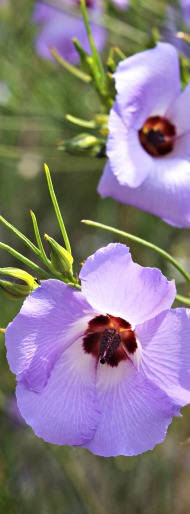Fitzgerald River National Park

Surrounding the inlets of the Gairdner, Fitzgerald and Hamersley Rivers, between Bremer Bay and Hopetoun on the South Coast of Western Australia, lies one of the most diverse botanical regions in the world. Considered “worthless” by early explorers of the area, the Fitzgerald River National Park is today renowned for its diverse and spectacular scenery and flora, which in turn supports a number of threatened animals. More than 1800 beautiful and bizarre species of flowering plants, as well as a myriad of lichens, mosses and fungi, have been recorded in Fitzgerald River National Park. This represents nearly 20 per cent of the total number of plant species in Western Australia, in an area that covers only a tiny fraction of the State.
The coastal hills, collectively known as the Barrens, are the most distinctive landforms in the park and many plants found nowhere else in the world are restricted to them. The Barrens are composed of quartzites; the tilted and folded rock beds, like those seen at East Mount Barren, were once layers of sand deposited on the sea floor. They were subsequently compressed, heated and uplifted by movements of the Earth’s crust. The park is also known for its spongelite cliffs, which are exposed along the Hamersley and Fitzgerald River valleys. The soft rock was formed more than 36 million years ago, when the sea level was higher than today and flooded the coast up to 65 kilometres inland, leaving the Barren Ranges as islands. Sponges proliferated in the warm shallow seas, and their silica skeletons in the silty sediments gave rise to the name of the rock type.
Sixty-two plant species are found only in Fitzgerald River National Park, with a further 48 species more or less confined to the park. The sheer diversity of plants is made all the more striking by the array of impressive flowers, unusual forms and bizarre leaf shapes, sizes and colours; attributes particularly prevalent in the most numerous families – the Proteaceae (banksias, hakeas and so on), the Myrtaceae (eucalypts, bottlebrushes and their relatives) and the Fabeaceae (pea-flowered plants). The Royal Hakea (Hakea victoria) is one of the most famous, and certainly the most striking, known from the park. Growing only in this area, it was first described by Colonial botanist James Drummond in 1847.
The tremendous variety of vegetation provides a haven for native animals and birds. As home to at least 19 native mammals, the park is one of the State’s most important in terms of faunal conservation. Several species have only recently been rediscovered in the park.
Would you like help arranging a visit to Fitzgerald River National Park?












